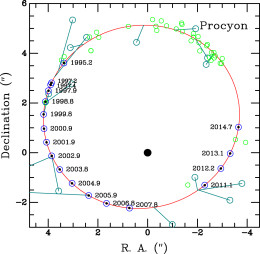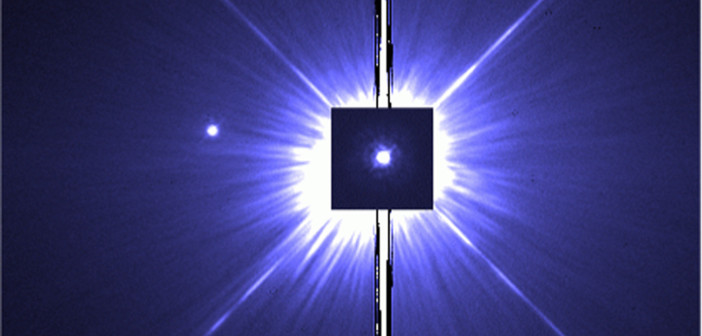The binary system Procyon, located a mere 11 light-years away, consists of a bright, subgiant star and a faint white dwarf — presenting a distinct challenge for astronomers to observe. But careful analysis of two decades of precise measurements with the Hubble Space Telescope has now finally revealed some of its secrets.
Challenging Observations
Perturbations were detected as early as 1844 in the orbit of Procyon, originally thought to be a single star. Astronomers of the time suspected that this wobbling was due to the pull of a companion orbiting Procyon, but it wasn’t until five decades later that the companion was first detected visually.
Why? Because the subgiant Procyon A is the 8th brightest star in the sky. Its companion, on the other hand, is a white dwarf that’s fainter (in visual wavelengths) by a factor of nearly 16,000! And the two stars are separated by an angular distance of less than 5”.
Due to the difficulty observing the system, the measurements of its motion — and resulting estimates of the masses of the two stars — have been a subject of debate for the better part of the last century.
Led by Howard Bond (Pennsylvania State University and the Space Telescope Science Institute), a team of astronomers has now analyzed two decades of Hubble observations of the system, combined with historical, ground-based observations dating back to the 19th century. Bond and collaborators used these data to precisely measure the orbital elements of Procyon and obtain dynamical masses of the two stars.
Surprising Mixing

Relative orbit of Procyon B around Procyon A. The red curve is the authors’ fit to the orbit, and the open blue circles are positions predicted by the orbital elements found. The black dots are the HST observations of Procyon B. The open green and turquoise circles are the (significantly less precise!) historical, ground-based observations. [Bond et al. 2015]
But the measurements of this system also have some interesting implications. One example arises when the authors apply the standard model for the evolution of a subgiant star to Procyon A. Using the new parameters, they find that Procyon A may have an unusually high amount of mixing of material beyond its convective core. If this is confirmed, it could mean that our understanding of how stars like Procyon A evolve may need to be updated.
Thus the precise measurements of the Procyon system have allowed the authors to not only pin down the parameters of the system, but also access new information about stellar physics near the main sequence. We’ve come a long way in the 170 years since Procyon was first observed to wobble!
Citation
Howard E. Bond et al 2015 ApJ 813 106. doi:10.1088/0004-637X/813/2/106


3 Comments
Pingback: precision astrometry of Procyon hints at surprises
Pingback: Allgemeines Live-Blog ab dem 14. 11. 2015 | Skyweek Zwei Punkt Null
Pingback: Una gigante y una enana « SEDA / LIADA